
by Mark Smiley | Mar 4, 2022 | Main Articles
Glendale Launching 10-Acre Entertainment Site; Denver Planning Massive Office/Apartments/Condos On 13 Acres Of Cherry Creek Shopping Center
by Glen Richardson

Entertainment Anticipation: Glendale’s Four Mile Entertainment District is finally breaking ground this year. A concert venue, movie theater, restaurants, shops, a proposed gaming hall, a 200-room hotel and more will make the venue one of the state’s top entertainment sites.
Just 1.8 miles apart, along the north bank of Cherry Creek, two massive projects are starting to go through the respective planning processes in Glendale and Denver with very different markets in mind. In Denver, 13 acres of retail space of the Cherry Creek Shopping Center will be converted into seven 12-story tall buildings composed of offices/condos/apartments. Conversely, the Glendale Planning Commission is expected to approve a 10-acre $150 million retail Entertainment District along its portion of the north bank of Cherry Creek this month.
Destined to become Colorado’s most unique entertainment locality, the 10-acre site now officially named the Four Mile Entertainment District is finally set to break ground in 2022, provided the Glendale City Council also approves the project at its May 2022 meeting. In Denver, the $1 billion redo of the west end of the Cherry Creek Shopping Center is just beginning the planning process, with the project projected to take up to 12 years with the first phase possibly completed in five years.
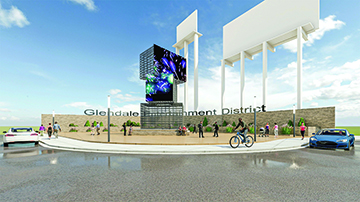
Corridor Sign Concept: Rendering illustrates what the entrance to Glendale’s Four Mile Entertainment District might look like along Colorado Blvd.
GLENDALE PROJECT
The Four Mile Entertainment District, along the banks of Cherry Creek, is bounded by East Virginia Ave., South Colorado Blvd., and South Cherry St. Plans call for the project to feature a vast array of choices including a 40,000-sq.-ft. live music site, an Alamo Drafthouse Cinema, plus restaurants and pubs.
A new 200-room resort hotel with an outdoor plaza, plus exclusive retail shops and a proposed app-based sportsbook gaming hall are also planned.
One-Stop Spot
The project is being designed as a one-stop destination where friends and family gather, take a date, or just relax at the adjacent resort hotel.
Valley residents and visitors can stroll tree-lined streets, shop, liste
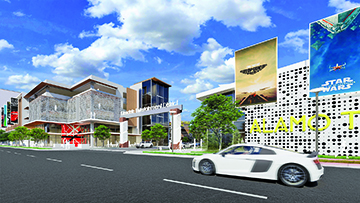
Alamo: Rendering shows the Alamo Drafthouse Cinema owned by developer Central Street Capital which will be an anchor in Glendale’s Four Mile Entertainment District.
n to music, or relax in landscaped outdoor plazas. Multiple indoor and outdoor restaurants will offer casual and fine dining options.
The district will feature a common consumption area where patrons can purchase drinks from different bars. With Glendale’s liberal last-call laws, clientele can buy drinks until 4 a.m. Moreover, Glendale Deputy City Manager Chuck Line suggests the area could also become the site of “Oktoberfest-type events” once the district opens.
Drive, Bike, Or Jog
Glendale and Denver take very different approaches to parking. Car friendly Glendale intends to mandate an abundant amount of parking spaces for its Entertainment District. Unlike many entertainment sites, visitors will have no trouble parking. Two large parking structures will be located within the district, and there will be a dedicated drop-off-pick-up area for Uber and Lyft.
Bordered on the southwest by Cherry Creek and its popular trail, visitors can easily walk, jog, or bike to the district.
Glendale is already Colorado’s destination for rugby and also houses some of the state’s leading event venues. In addition to the sports stadium, the enclave’s 16-acre Infinity Park is an indoor-outdoor entertainment hub.
Returning To Roots
“For the last decade, we’ve been working on trying to get this project going,” acknowledges Line. The development is designed to once again make Glendale the Cherry Creek Valley’s dining, drinking, and entertainment hot spot.
Many Valley old-timers still recall Cork ‘n Cleaver, Colorado Mine Company, The Lift, and other food and beverage spots that blossomed in Glendale’s earlier heydays. By developing the site as the Four Mile Entertainment District — Colorado’s entertainment stage stop — the transformation project will try to recapture Glendale’s bygone spirit.
Initially dubbed “Riverwalk,” the site was later named “Glendale 180” under a second false start by Lincoln Properties five years ago. Under a deal approved by Glendale’s City Council last summer, Denver-based Central Street Capital led by Rob Salazar, CEO-Founder, will develop the 10-acres of city-owned land. The investment management company invests only the funds of the family and its affiliated entities. The firm has invested in a wide variety of industries for more than 25 years. Information: Info@GlendaleEntertainmentDistrict.com.
DENVER PROJECT
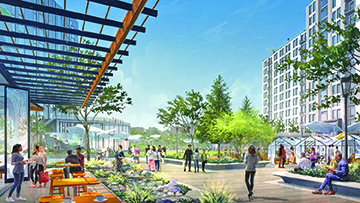
Casual Connection: Vision of proposed green space with amphitheater that would connect the Cherry Creek Shopping Center’s proposed west end to the mall’s retail space on the east.
While it hasn’t been easy for shoppers and residents in crane-studded Cherry Creek North over the last few years, a mammoth skyline-altering mixed-use project named Cherry Creek West will potentially be a different story. Plans for redevelopment with a $1 billion budget for the west end of the Cherry Creek Shopping Center will make the site much taller and denser, and will face significant parking and traffic challenges.
The big changes unveiled by East West Partners as 2022 commences would add office, residential, and retail in seven structures up to 12 stories tall on about 13 acres of land at the west end of the mall. A public amphitheater with green open space will connect the Shopping Center’s east end retail space to the new development.
Makeover is expected to start with four buildings that will have approximate

Mammoth Project: Rendering submitted to the City of Denver by East West Partners shows a layout of seven 12-story buildings to replace the Cherry Creek Shopping Center’s west end with offices/condos/apartments. Parking and traffic challenges are expected to be significant.
ly 780,000-sq.-ft. of office space, plus three condo-apartment homes with about 600 units. Each structure will also have retail space. The buildings will range in stature from eight to 12 floors, or 100 to 160-feet-tall.
West End Empty
Veteran Denver-based East West Partners, whose projects include Riverfront Park and Union Station, has a leasehold with owner Buell Foundation and mall owner Taubman on the 13 acres.
The project is planned from University Blvd. on the west to Clayton St. and from First Ave. on the north to the Cherry Creek waterway. Construction of a “landscape bridge” along a section of Cherry Creek North Dr. will provide pedestrian access to Cherry Creek.

Working Wonders: Staff of developer East West Partners study images and development plans for building, landscaping, appearance, mass orientation, and usage details for creek site.
Existing mall structures on about 2.7 acres will be demolished before construction begins. That is approximately half of the new construction area site. The additional development plot is currently parking lot space. Subsequent to the decision by Bed Bath & Beyond to relocate from the mall’s west end to Glendale in 2016, the west side has been mostly vacant. Soon thereafter Macy’s Furniture Galleries and The Container Store relocated to the east end of the Shopping Center. Only Elway’s and the Boulder Running Company remain on the west side.
Talks Began In 2015
Talks between East West Partners and Taubman about the project began in 2015. By 2019 the discussions became serious with both Taubman and the Buell Foundation in 2020, according to Amy Cara, managing partner of East West Partners. Cara, managed the Denver Union Station transit hub redevelopment and much of the adjacent residential and office.
Cara expected the city to begin its review of the plan and new zoning for the property by January 2022, or earlier. She also indicates the developers will work with their traffic engineers and the Department of Transportation & Infrastructure on the very significant impacts from traffic and construction.
Other companies that will work on the massive project include Gensler, Design Workshop, and BuildMark.

by Regan Bervar | Jan 21, 2022 | Main Articles
“The smallest of actions is always better than the noblest of intentions.” — Robin Sharma
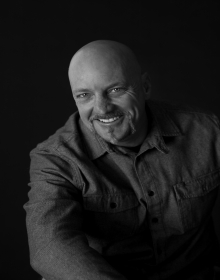 by Luke Schmaltz
by Luke Schmaltz
Tent-lined streets, debris-strewn sidewalks, and people languishing amidst it all — either injecting illicit drugs, relieving themselves, or walking around naked — have become unfortunate characteristics of central Denver.
According to an August 2021 report published by the Metro Denver Homeless Initiative (MDHI), 5530 individuals were unhoused or experiencing homelessness in Denver. These numbers reflect a February 2021 Point-in-Time (PIT) count, which may have fallen short of the actual numbers due to the safety issues of collecting in-person data due to Covid-19.
Of this populace, some turn to one of the numerous shelters across the greater downtown area. Others choose to “live on the street” in one of the many unsanctioned encampments in and around the city center and beyond. Yet others — perhaps the more fortunate of the destitute — have found temporary shelter in a Safe Outdoor

CVC: Colorado Village Collective is the purveyor of Safe Outdoor Spaces.
Space (SOS). The latter is a relatively novel form of addressing homelessness, and in Denver the primary administrator of such sites is known as the Colorado Village Collective (CVC).
The CVC is a Denver-based nonprofit led by ordained minister Cole Chandler, a Baylor University graduate with a Master of Divinity (M.Div.) degree. This NGO’s (non-governmental organization) boilerplate states, “Colorado Village Collaborative (CVC) exists to bridge the gap between the streets and stable housing. CVC is working to advance dignified solutions that significantly reduce Denver’s unsheltered homelessness population. Since its founding in 2017, CVC has launched five transformational housing projects, including two tiny home villages and three Safe Outdoor Spaces that have provided more than 54,815 nights of safe, dignified shelter in partnership with people coming from homelessness.”
An Honorable Pursuit
Currently, CVC maintains three Safe Outdoor Spaces. One is located on the Regis University campus in Northwest Denver, another at the Denver County Department of Human Services, 3815 Steele St., and a third, more recent site at 780 Elati in the Lincoln/ La Alma community on Denver Health and Medical Center property. This installment was pursued, in part to replace the Park Hill SOS (previously located at the United Methodist Church), and in part to offset removal of the large, unsanctioned encampment at the Four Winds American Indian Council at 5th and Bannock St. in the Baker District.
Jennifer Forker, M.Div., is the organization’s Development and Communications Director. She agrees that her organization had a busy 2021, stating, “We served nearly 300 people [last] year, a 300 percent increase over [the previous] year. We aim to serve more than 400 people in 2022. Our outcomes for 2021 include assisting 17 tiny home village residents and 47 SOS residents into more stable, permanent housing.” Forker also maintains that, “The city and the mayor have supported our emergency, temporary housing model, and we have a new contract to operate Safe Outdoor Spaces going before the City Council this month. We hope to have their support so we can carry on with our mission.”
Trouble In Paradise
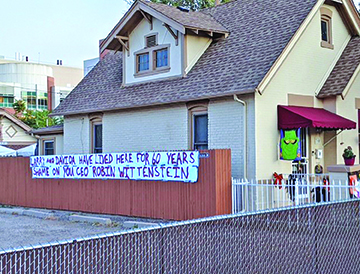
Opposed: Neighbors of the Safe Outdoor Spaces site at 780 Elati do not approve of Denver Health’s new installment.
At first glance, the CVC’s mission statement, their accomplishments, and the Denver city government’s endorsements are impressive. Yet, the SOS model is drawing scrutiny and outright criticism from residents and community leaders alike — particularly the most recent installment at 780 Elati St. The standout issues arising from the SOS model include concerns about neighborhood safety, the presence of undisclosed sexual predators, sanctioned use of illicit drugs, and inadequate solutions for citizens — people with addiction issues and mental health conditions — who require long-term comprehensive care.
Blame for the perpetuation of these concerns is aimed not only at the CVC, but even more so at Denver’s city government at large. Concerned local resident and native Coloradan Marc Spritzer sums it up succinctly, stating, “The city is, in my estimation, derelict in its duty to govern. They only enforce the laws they want to, not all the laws equally. They are not protecting citizens, including the unhoused. I would say what they are allowing them to do is even more cruel in the long run than sweeps. This is all really poor leadership — the Mayor, the City Attorney, the DA, the Judges, the city council, the State Legislators, and the Governor all have a hand in this.”
Despite this viewpoint, Britta Fisher, executive director of Denver’s Department of Housing Stability states, “Denver’s Safe Outdoor Spaces are making a difference in fostering stability, serving as a refuge to help move people from homelessness to housing. With 24-hour staffing, sanitation, support, and a myriad of services, temporary managed campsites are clearly transforming lives in our community. We are fortunate to have the Colorado Village Collaborative leading this innovative model, and the Department of Housing Stability is working to provide more support for safe outdoor spaces.”
Battlefield: Baker
Meanwhile, Dawn McNulty is a married mother of two, a longtime Baker district resident and an outspoken leader in the effort to expose and counteract the oversights of Safe Outdoor Spaces. “I personally do not see the proposed Safe Outdoor Spaces [to be] the compassionate, humane solution to Denver’s homeless problem,” she says. “In my humble opinion, it’s an interim solution that takes the pressure off the public officials.”
McNulty lives near the site of a previous unsanctioned camp at the Four Winds Tribal Council Church at 5th and Bannock. She was vocal, vigilant, and relentless in her efforts to draw attention to the hazards therein. “There was a woman with children living in a tent, and several people in the encampment openly doing illicit drugs on a daily basis,” she states. “There was vomit, human feces, urine, and needles in and around the camp, and when school at DCIS Baker (Denver Center for International Studies) started back up, I personally contacted Jolon Clark (Denver City Council) and then the Mayor’s office,” she explains. Once the camp was set to be “swept” the 780 Elati space was offered up by Denver Health to assuage the pleas for options from the Four Winds Tribal Council.
According to McNulty and other prominent community figures, the site was chosen, approved by city leaders, and the SOS build initiated with little to no engagement with the surrounding community, in spite of the fact that nearly 50 residents filed a joint appeal opposing the site. “This is when my good friend that lives in the Lincoln/La Alma community swiftly filed the appeal,” McNulty explains. “There was very little community engagement and a significant lack of transparency in the speedy process of placing the SOS site.”
Refutation Abounds
Details of this appeal are outlined in a December 6th article published by Business Den.com. In it, author Eric Heinz writes, “The 46 nearby residents claim the permit was approved outside of the authority of the zoning administrator and that the site was approved without accounting for ways to control various nuisances, such as its proximity to single-family homes, secondhand smoke, noise, outdoor lighting, littering, and pet control. They [permanent-housing residents] also have concerns about odors emitting from the portable toilets, and say that a potential homebuyer decided not to purchase in the neighborhood because of the encampment.”
Further, the La Alma/Lincoln Park RNA (Registered Neighborhood Association) released a statement on November 22, 2021, providing an in-depth expose titled “CVC Refuses to Provide Assurances to Low-Income, High-Minority Neighborhood Residents.” Here, the RNA states, “The 780 Elati site is operationally unprecedented for CVC. CVC will be operating the TSOS (Temporary Safe Outdoor Space) for the longest period of any TSOS to date. It will have the highest number of shelters. It will have the highest population of any previous site. Despite these factors and the unique characteristics of the neighborhood, CVC is unwilling to provide meaningful assurances to the neighborhood, something it has done with other neighborhoods. Therefore, the RNA reports that CVC has failed to negotiate a meaningful Good Neighbor Agreement.”
Safety Last

Homeless Camps: Encampments across the city are expanding.
Meanwhile, McNulty is quick to illustrate her growing concerns about the new SOS site in the La Alma/Lincoln Park neighborhood. “81 % of Denver voters opposed camping,” she begins. “How are Safe Outdoor Spaces any different when they allow use of illicit drugs on site?” Contrary to this, The CVC’s Jennifer Forker plainly states, “We do not allow violence or drug use in our Safe Outdoor Spaces.”
McNulty, however, provides an outright rebuttal to this, stating, “CVC Section III(O) of the Drug and Alcohol Policy in the Operational Plan for the 780 Elati encampment acknowledges there will be drug use at the site, which specifically provides for harm reduction materials available throughout the site, biohazard containers [for needles], Narcan/Naloxone, and safe use literature,” she says. “CVC allows and enables the use of illicit drugs in law abiding, tax paying, Denver citizen communities. With the certainty of mental health issues amongst this population, there is extreme opportunity for erratic, unpredictable behavior and Denver City officials are in support of this?” An exasperated McNulty continues, “Unlike prior SOS sites, CVC was unwilling to agree to Felony/Child/Violent Sex Offender resident background checks for 780 Elati Street, the Lincoln/La Alma SOS Site. Per the Colorado Sex Offender Registration Act, CVC should be required to disclose this information.”
Among McNulty’s concerns, another glaring oversight is the possibility that untrained, unqualified CVC personnel may be staffing Safe Outdoor Spaces which are occupied by people with addiction and mental health issues — since CVC claims to have personnel on site at all times. “CVC self-manages their SOS environments with 24/7 support staff, minimizing the need for police intervention,” McNulty explains. “Yet, they are unwilling to disclose incident reports to the communities [in which] they reside. This is important health and safety information for communities where the SOS sites are located, as the [SOS] residents are free to roam these communities.”
Diagnostic Prognosis
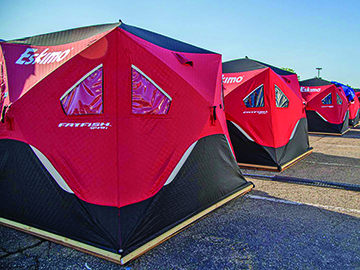
Stepping In: CVC is doing the civic duty of the Denver city government.
Currently, what it all seems to add up to is a non-governmental organization doing important civic work for the homeless which an existing and capable city government is unable or unwilling to do themselves. In the process, taxpaying, law-abiding citizens are becoming deeply concerned for the sanctity of their communities while the SOS initiative — although worthwhile — is putting but a tiny dent in the overall issue of homelessness. Ironically, it appears that just about everyone involved has, more or less, the same interest in mind: to mitigate homelessness and curtail the inhumane conditions experienced by the unhoused. The issue is pervasive and has been a forefront concern for decades. Yet, the concerns have become nuanced — and groups from one neighborhood to the next want solutions that resonate with their specific concerns. This is an instance where solidarity between HOAs, neighborhood watch groups, the Denver Police Department, SOS providers, mental health experts, and — most importantly — homeless people — could create a sustainable solution for a long-term problem.
Not to be outdone, however, the Denver Department of Housing Stability (HOST) has alas, announced their own initiative. The “Five-Year Strategic Planning Efforts” addresses all of these issues and more. The 14-point plan includes goals to “Reduce unsheltered homelessness by 50%,” “Measurably end veteran homelessness,” “Reduce the average length of time residents experience homelessness to 90 days,” and much more. Whether they can achieve these aims after grossly underperforming in this arena for decades is a subject for deep speculation. But, if you’re a betting person, it’s best to anticipate a strikeout rather than a home run.
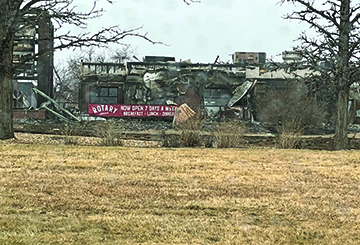
by Jessica Hughes | Jan 21, 2022 | Main Articles
by Jessica Hughes
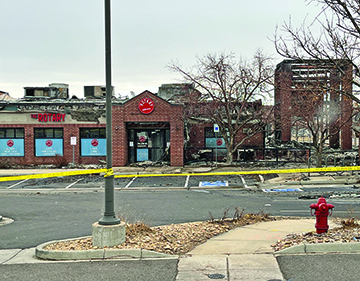
Out front, the day after the fire. Photo provided by Scott Boyd
Local Denver restaurant, The Rotary, first opened its doors in January 2021, at the corner of Holly Street and Cedar in the Hilltop neighborhood. They opened during the pandemic, and now, almost exactly a year later, are recovering from the Marshall Fire that recently scorched parts of Boulder County.
The Rotary’s second location in Louisville opened on December 15, 2021. But two weeks after opening, the wind-fueled Marshall Fire ignited on December 30, quickly ripped through the towns of Louisville and Superior, destroying nearly 900 homes in the short time of six hours.
Scott Boyd, a Louisville resident and co-owner of The Rotary, remembers that day looking out the window of his home as he headed to work at the restaurant. The first thing he noticed was a bunch of smoke and wind. When he arrived at work, there was even more smoke and the same wind intensity, plus ash inside the restaurant. Soon, the smoke and wind became bad enough that he decided to close for the day and sent everyone home.
As he was shutting down the restaurant, Scott peered across the parking lot in amazement as nearby bushes rose in flames

Fire damage seen from the backside of the restaurant. Photo provided by Scott Boyd
and watched as the fire quickly advanced toward his restaurant. Locking the door behind him, he fled and went home to grab his wife, kids, and pets.
Boyd and his family evacuated to a friend’s house in nearby Niwot, where they watched the destruction of the restaurant through the surveillance cameras. “It was so surreal,” says Boyd. “To watch in real-time as the flames tore through the restaurant.” But as he watched with his wife, kids, and friends, he knew he wasn’t alone in this. “It was nice to know I had support.”
Fortunately, Scott’s home was not one of the ones destroyed. He says he feels fortunate to only have lost a business and not his family’s home and belongings.
“Now begins the challenge of rebuilding,” Boyd says as he describes the mess that was left after the fire. Between the fire sprinklers that soaked everything and then the snowstorm that followed the next day, freezing almost everything, including pipes, there are many factors to consider in terms of the damage. The process to rebuild will take some time with COVID and current supply chain issues, but nonetheless, they do plan to rebuild in Louisville.
Boyd says so many people have reached out to see how they can help, but he says, “Find a family that lost everything and give them the help. We’ll be fine.”
The Rotary was started by Scott, his
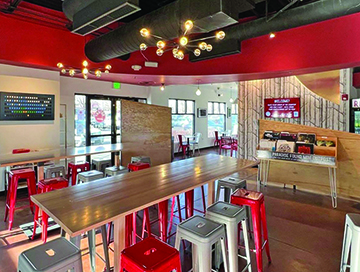
Inside The Rotary before the Marshall Fire. Photo provided by Scott Boyd
brother Brian, and their life-long friend Don Gragg, a celebrated chef. What began with a space inside the Avanti Food and Beverage in Denver, quickly required its own space as the COVID pandemic made it hard to sustain a seat at the table inside a food hall.
Eventually opening a standalone establishment in Denver’s Hilltop Neighborhood, the three owners saw their life-long dream of owning and operating a restaurant realized, all in the middle of a pandemic. What was a real hustle to stay afloat during 2021, they knew they had something special and forged on. “We’re like the little restaurant that could,” Boyd chuckles.
“We’ll come out stronger on the other side of this,” says Boyd, who feels the community has done an excellent job of coming together with donations and volunteering to help clean up the affected areas.
You can help Boyd and others affected by the Marshall Fire by donating at:www.commfound.org/grants/get-grant/Boulder-County-Wildfire-Fund.
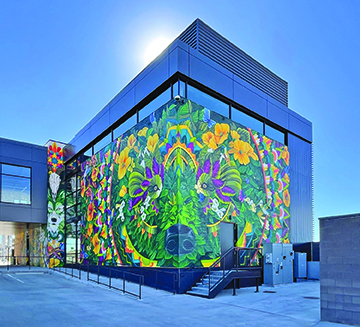
by Mark Smiley | Jan 21, 2022 | Main Articles
Two New Developments Begin To Shift Shopping To Colorado Blvd. Corridor As Downtown Retail Struggles
by Glen Richardson
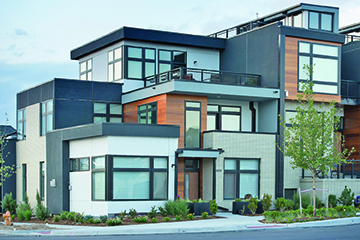
Multiple Housing Styles: Boulevard One is known for numerous types of bungalows, apartments, townhomes, and condos. Photo is of project’s Modern Row Homes.
Two of the Valley’s high-profile retail projects along the Colorado Boulevard corridor — the 9th & Colorado and Boulevard One at Lowry developments — have hit major milestones as they near completion, ramping up the shift in shopping dynamics away from downtown Denver.
Denver workers were thrust into a sudden, chaotic experiment in working from home when the pandemic shut down the city’s urban nucleus known as downtown. Moreover, as 2022 begins, that experiment isn’t close to ending.
The downtown real estate market remains in turmoil. Covid has dealt a huge blow to its vibrancy, destroying office and restaurant business that served as its lifeblood. When the pandemic is finally over, one in six workers are projected to continue working from home or co-working at least two days a week, according to a survey by the Harvard Business School.
Covid Is Culprit
Covid-19 was already shifting shopping eastward along the Colorado Blvd. corridor. As more Valley shoppers decamp from downtown to retail sites along the corridor, they are already stimulating the addition of new shops and restaurants.
The Chronicle looks at the status of the two retail undertakings nearing completion that are already drawing retail away from Denver’s downtown core as new businesses rush to open:
9th & Colorado
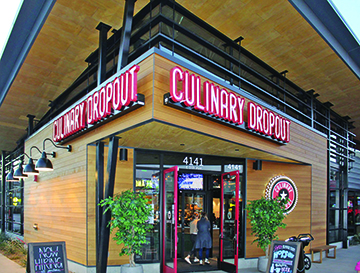
New Restaurant: Culinary Dropout’s first Colorado location opened in November at 4177 E. 9th Ave. in the 9+CO development. The restaurant is known for its hearty and classic American-fare, with options ranging from sandwiches and burgers, to fried chicken and 36-hour pork ribs.
The redevelopment of 9th and Colorado has been moving forward. Most of the blocks now have completed projects on them, leaving only a few open parcels left. Overall, this 26-acre development provides over 2-million-sq.-ft. of infill making this a major mixed-use urban center in the Hale neighborhood.
While only being a single-story structure, Block-1 contains seven retail pads, with considerably more than half of them filled. A 10-screen movie theater has moved in on Block-2, anchored by AMC. In addition to the movie theater, more retail resides around this block totaling 44,000-sq-ft. Dubbed Ella CityHomes, 35 for-sale townhomes occupy Block-3. Most of the homes have already sold.
Block-4 contains a seven-story parking garage, providing most of the structured parking for the redevelopment. The garage is partially wrapped, with a 64,000- sq.-ft. office building to the south. Ground-floor retail also wraps around the entire ground floor.
There are no concrete proposals on Block-5, however, earlier master plans envisioned a hotel and more mixed-use buildings. Block-6 contains the nurses’ dormitory from when this area was a medical campus. Currently, there are plans to rehabilitate the building while adding additional residential units toward Ash St. plus additional open park space.

Art Of The Draw: Project draws retailers by adding art such as the piece above titled “A Living Wall” by Kiri Leigh Jones.
Now named Theo, Block-7 South was the first project to be completed in the redevelopment providing 275 apartment homes plus 40,000-sq.-ft. of ground-floor retail. One of the few existing structures in the Block-7 wrap is the north parking garage. The east side of this garage is wrapped with a three-story structure containing 17 townhomes-apartments. Milo Apartments occupy Block-7 East. This project provides 319 homes in an eight-story building.
Blocks 8-10: In blocks 8-10, only Block 8 is currently under construction. Most of the block is complete with the new Hale Park. The other portion is near completion with two single-story retail spaces. Preliminary plans for Block 9 call for a condo building. Greystar recently finished Overture, an eight-story building providing 208 age-restricted homes in Block 10. Residents over 55-years-old are moving into this building.
A variety of restaurants surround the 9+CO development including Postino, Pizzeria Locale, Frank & Roze Coffee, Hopdoddy Burger Bar, and Gelato Boy. The latest additions are Culinary Dropout and its new, next-door sister restaurant Blanco Cocina + Cantina which opened late last year and are owned and operated by Fox Restaurant Concepts, a company based in Arizona.
In addition, retail is popping up including CVS, M. Vince’ Nail Spa, Chase Bank, and Elevation Cycles. When completed, there will be close to 50 retail shops and restaurants occupying the former home of the University of Colorado Health Sciences Center which originally opened in 1924.
Boulevard One
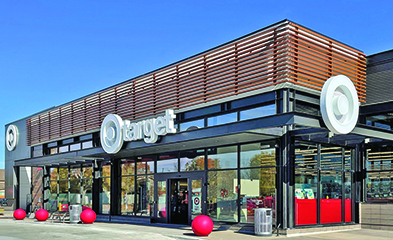
Lowry On Target: Retail seems to be on target, with the grand opening of Boulevard One planned for the first half of this year. Development has signed about 20 retailers including a small-format Target.
The grand opening for Boulevard One at Lowry is planned for the first half of this year (2022). Shopping, dining, and entertainment are designed to be a local affair at this site, with a major retailer and grocer already announced. Residents can walk or cycle on neighborhood paths to their favorite hotspots within the Exchange Building, the shopping space in the development.
Kelmore Development — in collaboration with Confluent Development — planned and built the mixed-use retail area at the northwest corner of E. Lowry Blvd. and Quebec St. The five-acre site contains 175,000-sq.-ft. of commercial space designed by Norris Design and Open Space Architecture. The Exchange Building — with 20 retailers already signed — features restaurant, retail and office space, plus a restaurant sitting on the community park across Lowry Blvd.
About 500 parking spaces, 231 of them in an underground parking garage, are at the site. Woven among the boutiques and entertainment venues, there are inviting outdoor seating areas, shared courtyards and landscaping, with the community park directly across the street.
A small-format Target is the anchor tenant for the development, occupying approximately 30,000-sq.-ft. of custom-designed space. The store is about one-quarter the size of a traditional full-sized Target and offers a shopping experience to meet the needs of Lowry residents, including same-day pick up and drive up.
Grocer Is Co-Anchor

Exchange Building Co-Anchor: Boulevard One development will feature Denver’s first Clark’s Market.
Colorado-based specialty grocer Clark’s Market is the co-anchor in the Exchange Bldg. Located at Lowry Blvd. and Pontiac St., the 25,000-sq.-ft. store is the seventh Colorado location but the brand’s first in Denver. The store is expected to open in the first half of this year.
Shoppers can look forward to natural, organic, and gourmet foods, including artisan baked goods, beef, a fresh fish ice table, chef-prepared meals, specialty cheeses, stone-fired pizza, a circular gelato wheel, plus a liquor store. Envisioned as a gathering hub for Lowry residents, Clark’s Market plans to pour draft beer for shoppers on site.

by Mark Smiley | Dec 17, 2021 | Main Articles
FAA Warns Rollout Of 5G Network Could Also Affect Air Safety Including Flights From DIA
by Glen Richardson

Denver’s cellphone carriers are set to begin shutting down their older networks as 2022 gets underway. If and when they do and you have an older device you won’t be able to text, phone friends or make an emergency 9-1-1 call.
The shutdown dates were set to start Jan. 1, 2022, and continue throughout the year. Verizon says their 3G CDMA network will go away no later than the end of 2022. T-Mobile plans to retire all its 3G networks, including those obtained through its merger with Sprint, as quickly as possible as this year begins.
The changeover dates initially appeared to be confirmed. Phone carriers here and elsewhere have been proceeding as if they were permanent and established.
Air Safety?
However, the FCC warned as 2021 was coming to an end that the 5G rollout would impede air safety for pilots and slow airline travel, including traffic at DIA in Denver. Just after mid-November, carriers agreed to delay their launch of 5G C-band spectrum licenses until Jan. 5, 2022, due to the FAA concerns.
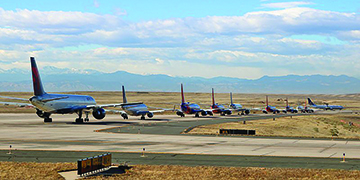
DIA Delays: FAA says the rollout of 5G may affect air safety, including at DIA. Pilots apparently will also tell passengers that new 5G devices should be turned off or switched to airplane mode during flights.
In a special information bulletin released at the time, the FAA said operators “should be prepared for the possibility that interference from 5G transmitters and other technology could cause certain safety equipment to malfunction, requiring them to take mitigating action that could affect flight operations.”
The bulletin said “there have not yet been proven reports of harmful interference,” but recommended pilots also remind passengers that all portable electronic devices equipped with 5G be should be turned off or switched to airplane mode during flight.” Following Thanksgiving, however, The Wall Street Journal reported that, “AT&T Inc. and Verizon Communications Inc. said they would limit some of their fifth-generation wireless services for six months while federal regulators review the signals’ effect on aircraft sensors.”
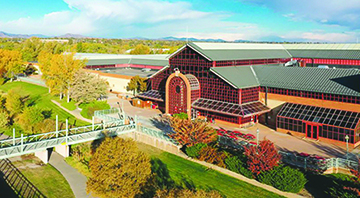
Definitive Dish Deal: Colorado dropped out of the T-Mobile-Sprint merger lawsuit to allow Littleton-based Dish Network to create nation’s fourth wireless provider. Dish is attempting to build a cloud-native 5G network.
Rollout Impact
The slowdown or even a longer delay may yet occur as the two government agencies — the FAA (Federal Aviation Agency) and FCC (Federal Communications Commission) — feud over nationwide safety. The Wall Street Journal said the compromise was proposed in a letter sent to the agencies by the carriers.
If and when the rollout begins, here’s what to expect: Your older phone(s) will no longer take phone calls; furthermore, apps and websites will no longer work over a cellular connection.
Killing off the slower networks, moreover, will upset much more than just your cell phone: older cars have 3G systems, as do security cameras and other systems. Examples include medical alert devices plus e-readers like the Kindle.
New Nightmare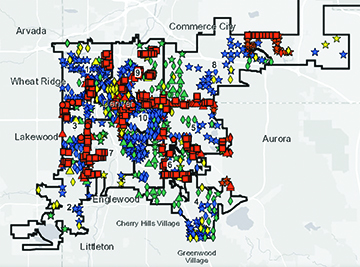
Denver is one of the first major U.S. cities where telecommunications companies sta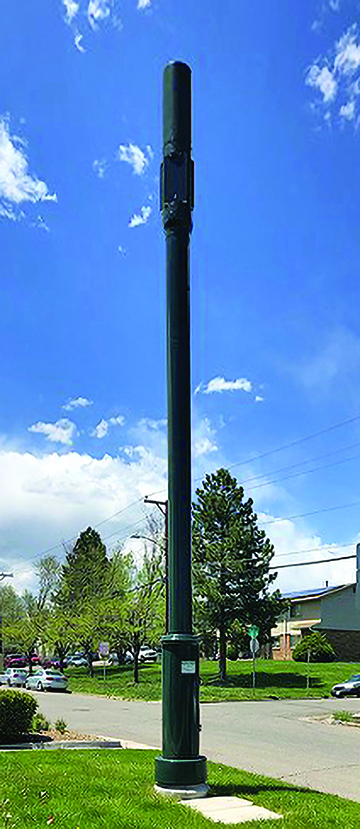 rted installing the super-powerful cell towers. Companies providing 5G service here — AT&T, Verizon and T-Mobile — are doubling the number of 5G towers around the Mile High City.
rted installing the super-powerful cell towers. Companies providing 5G service here — AT&T, Verizon and T-Mobile — are doubling the number of 5G towers around the Mile High City.
Valley residents were told they were the beginning of, “a new era of digital interconnectedness.” Cell phone carriers even claimed, “It was the beginning of the “Fourth Industrial Revolution.”
Over the past couple of years, however, residents in neighborhood after neighborhood have found them to be an infrastructural nightmare.
Poles A Drawback
Homeowners say the poles are ugly, spoiling the scenery and harming their property values.
As time has gone by, residents in several locations have uncovered additional problems but contend they can’t get the cell phone companies to fix them or even acknowledge problems exist. The city, however, can’t stop the carriers from installing the poles, thanks to a 2017 state law that says companies should generally be allowed to build them on the public right of way along city streets.
Furthermore, many families remain uneasy that the poles could also cause adverse health effects. Will the added small cells mean there are higher amounts of RF-waves surrounding people? Bottom line: Nothing conclusive has been ruled out or in and the long-term effects remain unknown.
Colorado Deal
Colorado, as many local residents likely recall, was originally one of 12 states that joined a lawsuit to stop the merger claiming it would hurt consumers and cut competition.

Changeover Collision: Rollout of 5G technology by Denver’s cellphone carriers this month will shut down older cellphones (pictured). If you have a Samsung Galaxy S4 or older it is also a 3G device, but newer models may still need an update to work.
The state pulled out of the lawsuit, however, when T-Mobile agreed to sell its subsidiaries Boost and Virgin Mobile to Colorado-based Dish Network for $5 billion. The deal allowed Dish to take over T-Mobile and Sprint’s service bands, creating the nation’s fourth wireless provider.
Eventually the compact will create, “thousands of new jobs,” the state said when announcing the deal. Potential job estimates according to carrier sources, are currently slightly more than 2,000. To date, Dish is still building the network in conjunction with more than 35 other companies. When completed it will link about nine million customers of Boost plus cable companies Comcast and Charter by relying on Verizon’s network.
T-Mobile Tactics
Meanwhile, in what some industry insiders are calling “double-dealing,” some observers are insinuating that T-Mobile is trying to crush the Dish deal.
Prior to the close of 2021, T-Mobile launched substantial promotions intended to get back the very customers it was required to sell to Dish as part of the Sprint merger. Even without the T-Mobile promotions, Dish was expected to lose more than 8.9 million wireless subscribers.
T-Mobile is the brand name used by the mobile communications subsidiaries of the German telecommunications company Deutsche Telekom AG. The brand is active in the Czech Republic, the Netherlands, Poland, along with the U.S.
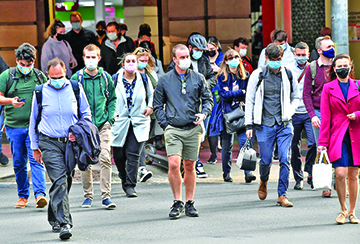
by Charles Bonniwell | Dec 17, 2021 | Main Articles
So Why Are We Still Wearing Masks? Mask Mandates Cause End Of Tri-County Health
by Charles Bonniwell
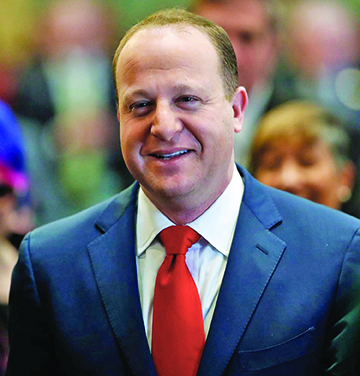
Canny Politician: Colorado Governor Jared Polis has gone on a national media tour receiving praise for declaring the COVID-19 medical emergency over and the lack of any need for mask mandates while 75% of the state’s population still remain under local mask mandates.
Colorado Governor Jared Polis made national news by appearing on Colorado Public Radio and declaring that after 16 months since he issued a medical emergency, the emergency was “over” and that there would be no statewide or vaccine requirements. He opined that:
“You don’t tell people to wear a jacket when they go out in winter and force them to (wear it). If they get frostbite, it’s their own darn fault. If you haven’t been vaccinated, that’s your choice. I respect that. But it’s your fault when you’re in the hospital with COVID.”
It was quite a reversal from just a few weeks earlier when he halted elective or cosmetic procedures to try to save hospital beds for COVID patients.
So why then are people in Metro Denver still wearing masks? Polis had stated that, “Public health [officials] don’t get to tell people what to wear; that’s not their job.” That is apparently not what some local health officials in Colorado believe.
On November 23, 2021, Denver Mayor Michael Hancock reinstated mask mandates requiring all indoor Denver businesses and venues “mask up” unless they choose to require proof of vaccination. Hancock followed the lead of Jefferson, Adams, and Arapahoe counties.

Still Under The Mask: Notwithstanding Colorado Governor Jared Polis declaring the COVID-19 pandemic emergency over and there being no need for statewide mask mandates, 75% of the population of the state are under some form of a mask mandate.
Tri-County Health Acts
Tri-County Health Department had preceded Hancock after waiting in vain for Polis to impose new statewide mask mandates. “If the state is unwilling to act, metro-wide action to implement mask mandates can provide some benefit given the size of our population and number of hospitalizations,” said Dr. John Douglas, executive director for the Tri-County Health Department, which covers Adams, and Arapahoe counties.
Other counties in Colorado that also presently have mask mandates are Boulder County, Larimer County, Pitkin County, and San Miguel County. In fact, notwithstanding the lifting of the state emergency by Polis, over 75% of the population of the state still live under mask or vaccine mandates.
Polis was not going, however, full Governor Ron DeSantis, who banned all local mask mandates in Florida.
While Polis received generally positive press nationally on his declaration that the COVID-19 emergency is over, not everyone in Colorado was thrilled. The editorial board of the Aurora Sentinel criticized Polis saying his action was “a grave disservice” to the state and that “the pandemic emergency in Colorado and across the nation is not over. It is far from over.”
The Destruction Of Tri-County Health
Local mask mandates are also not popular in Colorado in some circles. The Tri-County Health Department was until recent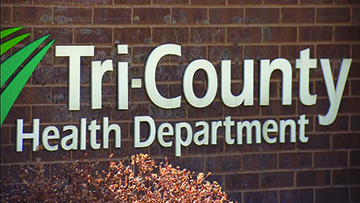 ly considered the premier and most respected health department in the state covering 1.3 million people (25% of the state population) in Adams, Arapahoe, and Douglas counties with 431 employees. Founded in 1948, it will be totally dismantled in just over one year due almost solely to mask mandates. Many blame Dr. John Douglas, the 69-year-old executive director of the department, and his insistence on mask mandates.
ly considered the premier and most respected health department in the state covering 1.3 million people (25% of the state population) in Adams, Arapahoe, and Douglas counties with 431 employees. Founded in 1948, it will be totally dismantled in just over one year due almost solely to mask mandates. Many blame Dr. John Douglas, the 69-year-old executive director of the department, and his insistence on mask mandates.
The Tri-County Health mask mandates, first ordered in July of 2020, allowed municipalities and counties to opt out. Those mask mandates preceded those that Polis issued statewide. At the time, Polis announced: “Wearing a mask is not a political statement. I don’t know how, in anybody’s mind, this became a political football.”
Douglas County, all of whose county commissioners are Republicans, balked and threatened to leave Tri-County Health when Tri-County decided to prevent counties from opting out from its mask mandates. Douglas County formalized its withdrawal in September of 2021. At the time, Tri-County also imposed the mandate for all people above the age of two in all schools and childcare facilities.
Adams County, all of whose county commissioners are Democrats, had also opted out of the Tri-County Health mask mandates. When that option disappeared, on October 19, 2021, the commissioners elected to leave subject to the mandatory one year notice.
That only left Arapahoe County whose county commissioners are split between Republicans and Democrats. On December 14, 2021, Arapahoe County, after over 60 minutes of public testimony demanding that the county get out of and remove the mask mandates and other COVID-19 restrictions, the commissioners voted to say goodbye to Dr. Douglas and his Tri-County Board.
Douglas Views The Wreckage
When interviewed by The Denver Post on the dissolution of a 74-year-old institution like Tri-County Health over mask mandates, Dr. Douglas stated:

Clueless: The executive director of the Tri-County Health Department, Dr. John Douglas, is blamed for the demise of the 74-year-old institution with mask mandates of dubious value. If the 400 plus workers of Tri-County’s Health Department who are losing their jobs are looking for a mea culpa from him they will be disappointed as he doesn’t appear to see what he might have done differently.
“If you had asked me to take a multiple-choice test three years ago about what would be the most controversial issues if we were to have a pandemic, and mask-wearing was one of my options, it would have been last on whatever list you gave me. I could just not have imagined that this would have become so.”
Given that the efficacy of non-surgical masks in preventing COVID-19 is a matter of dispute particularly as it applies to children, it does not appear to occur to Dr. Douglas that perhaps he should have given some credence himself to listening to all of the people who went before the various county commissioners demanding to leave Tri-County Health over mask mandates.
The question remains, given all that has happened, why most Coloradans are still required to wear masks. As a practical matter, the mandates of Tri-County Health are still law until the end of 2022 when the entity dissolves. Of course, people want to wear masks for health or political reasons. Enforcement of mask mandates, however, won’t be a law enforcement priority so many who do not enjoy wearing masks will flout the applicable law and that will certainly not help the moral authority of future local health directives.






























